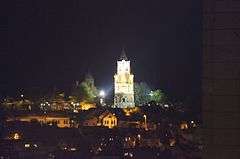Gardoš Tower
| Gardoš Tower | |
|---|---|
|
Кула на Гардошу, Миленијумска кула Кула Сибињанин Јанка | |
 Gardoš Tower at night | |
 Location within Serbia | |
| Alternative names |
Millennium Tower Tower of Janos Hunyadi |
| General information | |
| Location | Zemun |
| Town or city | Belgrade |
| Country | Serbia |
| Coordinates | 44°50′54.0″N 20°24′35.1″E / 44.848333°N 20.409750°E |
| Completed | 20 August 1896 |
| Height | 36 m (118 ft) |
| Website | |
|
www | |
Gardoš Tower (Serbian: Кула на Гардошу) or Millennium Tower, (Serbian: Миленијумска кула) and also known as Kula Sibinjanin Janka (English: The Tower of Janos Hunyadi Serbian: Кула Сибињанин Јанка) is a memorial tower located in Zemun, Serbia. It was built and officially opened on 20 August 1896 to celebrate a thousand years of Hungarian settlement in the Pannonian plain.
As part of Old Town core of Zemun, and also located in the middle of the Zemun Fortress, tower is protected both as Spatial Cultural-Historical Unit of Great Importance, and as a Protected Monument of Culture.[1][2]
History
It was part of the massive construction effort which included buildings in Budapest as well as four millennium towers on four directions of the world. Being the southernmost city in then Hungary within the Austria-Hungary, the tower was built on the ruins of the medieval fortress on Gardoš hill, Taurunum, which barely survived today (only angular towers and parts of the defending wall). The tower was built as a combination of various styles, mostly influenced by the Roman elements. The tower is 36 m (118 ft) tall and, being a natural lookout, it was used by Zemun's firemen for decades. Today, the tower is better known after the Janos Hunyadi, who actually died in the old fortress, 440 years before the tower was built.[3][4][5]
The tower was projected by the Hungarian architects. It was finished on 5 August 1896 and officially opened 15 days later. Soon after it was built, inhabitants of Zemun began to call it colloquially after Janos Hunyadi.[4] The tower was severely damaged in 1914 during the Austrian-Serbian fighting in the World War I, but was renovated during the Interbellum. It was also renovated in 1962.[6] In 2010, remains of two human bodies, dated to the 3rd century AD, were discovered near the base of the tower and nicknamed "the oldest Zemunians". In the early 2010s the tower was renovated and got a decorative lights.[5]
See also
References
- ↑ Monuments of Culture in Serbia: Старо Градско језгро (SANU) (in Serbian) (in English)
- ↑ Monuments of Culture in Serbia: Земунска тврђава (SANU) (in Serbian) (in English)
- ↑ Kula Gardoš - Istorijat (in Serbian)
- 1 2 Snežana Prljević (4 April 2012), "Zemunski Gardoš", Politika-Putovanja (in Serbian), p. 7
- 1 2 Dragana Jokić Stamenković (27 April 2011), "Sjaj Kule na Gardošu", Politika (in Serbian)
- ↑ N.Miković (7 August 2008), "Kula na Gardošu – turistička atrakcija", Politika (in Serbian), p. 1
External links
| Wikimedia Commons has media related to Kula Sibinjanin Janka. |
| Wikimedia Commons has media related to Zemun Fortress. |
